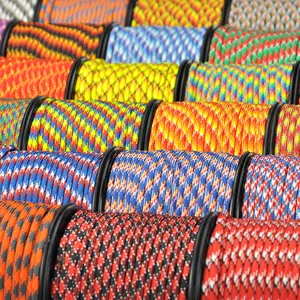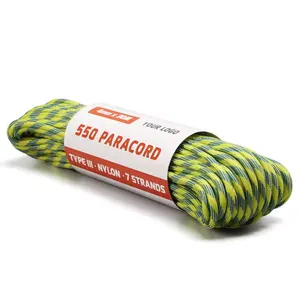(3565 products available)





























































































































 Ready to Ship
Ready to Ship

























































































The different types of paracord braids knots include;
Simple knots
Simple knots are the most basic types of paracord knots. They are easy to do and require minimal skills. The most common simple knot is the overhand knot. This knot is made by taking one end of the cord and placing it over the other end. Then, the cord is looped around itself and pulled to tighten the knot. The knot creates a loop at one end of the cord. Another example of a simple not is the square knot, which involves tying two different knots in a particular order. First, the right-hand cord is placed over the left-hand cord and pressed down. Then, the left-hand cord is placed over the right-hand cord and pressed down.
Compound knots
Compound knots are more complex than simple knots. They involve combining two or more simple knots. Compound knots are more stable and secure than simple knots. The most common compound knot is the bowline knot. This knot is made by creating a loop with the paracord and putting the working end through the loop. Then, the paracord is pulled to tighten it. The bowline knot is widely known for its strength and ability to tighten itself. Another example of a compound knot is the fisherman knot. It is formed by using two overhand knots on two different lines and joining the two lines.
Knots with characteristics
Knot characteristics vary depending on the type of cord used. For instance, the braid has three working ends, and a rope is made of two different pieces. The braid will have a smooth finish and lay flat when finished. The finish is not only good-looking but also practical since it makes the knot easier to adjust and tighten.
Fancy knots
Fancy knots are decorative and aesthetically pleasing. They require high skill and technique to complete. The most common fancy knot is the monkey fist. It involves making a ball at the center of the knot and wrapping the cord around it several times. This knot is used as a keychain.
Paracord braids and knots have several practical and recreational applications. Some of them include:
Survival Bracelets
Survival bracelets made with the cobra knot are popular. They can be useful in many emergencies. They can be used to build shelters, lower objects, or tie things together. Many people carry survival bracelets with them when hiking or doing other outdoor activities.
Keychains
Keychains made with paracord are strong and easy to hold. The knots used to make them are both useful and beautiful. People who enjoy outdoor activities often make these keychains for their keys.
Handle Wraps
Knotting a paracord around the handle of a tool or weapon gives it a better grip. This method also makes the handles more secure and long-lasting. Garden tools, fishing rods, axes, and firearms have their handles wrapped with paracord.
Dog Leashes and Collars
The diamond knot and other paracord knots are used to make strong dog collars and leashes that can be used every day. They are long-lasting and easy to hold. They are also water-resistant and can endure any weather condition.
Backpack Accents
Some people use paracord to make different knots and braids on their backpacks. They do it for fun, and some people do it because it is a nice way to decorate. These backpack accents include zipper pulls, handle wraps, and attachment points.
Aviation
Paracord is used in aviation to make many things, such as airplane steering wheels, seatbelts, and cargo ties. Pilots and airplane crew members may use paracord knots and braids to tie up some things in the airplane.
When selecting the paracord braids knots for a particular task, one should consider the following factors:
Purpose
When the user chooses a specific paracord knot, they should consider its intended use. Some knots are more effective than others when it comes to specific tasks. For instance, if the user is making a bracelet for a daily use, he or she might consider a braid like the cobra or chain, which has a nice appearance and is very useful. If a person were to make a fishing line, then they would use the fisherman's knot since it is very useful for tying two lines together.
Knot Strength
It is important to choose the right type of knot strength depending on the type of work one is doing. Knots such as the bowline knot or the double fisherman's knot are known for their strength and can be used in life-and-death situations. They do not untie easily once they have been tied.
Adjustability
Some paracord knots are adjustable, so if someone needs to change the fit of their bracelet or sling, they can do so easily by adjusting the knot. The sliding knot is an example of an adjustable knot.
Skill Level
It is necessary to choose a braid that is suitable for one's abilities. Some braids require advanced knot-tying techniques while others are simple. For instance, the King Solomon braid is a simple braid that can be done by anyone, but the fishtail braid requires more skill. If someone has yet to try braiding before, it would be best to start with a simple braid to avoid getting frustrated.
Durability
Durability is another factor that should be considered. Not all knots are built to last, so if someone is doing a job that will put the knot to the test, they need to choose a durable knot. The double knot and the treble knot are two examples of durable knots.
Paracord braids and knots are not just for show; they serve many functions and features depending on the design.
Survival Applications
Survival bracelets with a knot can have many applications, especially in emergencies. They can be used to build shelters, tie down gear, make splints, or even start a fire using the threads when a paracord is braided. These survival bracelets with a knot are made specifically for this because they are made to be strong and long-lasting.
Decorative Applications
Some paracord knots and braids are made to look good and are used in keychains, belt loops, or other items. The decorative knot keychain is an excellent example of this because it has a unique design and is very useful.
Fishing Industry
Some paracord knots, like the fisherman's knot, can be used to attach hooks to lines or make nets. They are crucial for many everyday tasks.
Sailing
Another application for paracord braids and knots is sailing, where they can secure sails, moorlines, and rigging. One well-known sailing knot is the bowline knot.
Sports
Knotting and braiding paracords can create grips for tennis rackets, handles for kayaks, and other things that people in the sports world use. The sportsman's grip is a perfect example of this; it provides a solid and comfortable hold for more excellent control and less hand fatigue.
Q1: What paracord is best for knots and braids?
A1: The best paracord for braids and knots is the 550 paracord. It is durable, versatile, and strong. Also, it can carry a weight of around 550 pounds. This paracord has a nylon outer sheath that makes it abrasion-resistant. In addition, it has seven to eight inner strands that make it more flexible.
Q2: Can paracord be braided without a jig?
A2: Yes, paracord can be braided without a jig. However, braiding with a jig is much easier and faster. So, if one does paracord braiding often, using a jig will be a great investment. Braiding with a jig helps to create even and clean braids. It also helps in making more complicated braids. This is because the jig can hold the paracord in place.
Q3: What is the difference between knots and braids?
A3: Knots and braids are different, but people confuse them. A braid is made of three or more strands that are twisted together. On the other hand, a knot is a braid with a simple or more complicated tie made on a rope.
Q4: What is paracord used for?
A4: Paracord is used for many things, such as making keychains, handles, and bracelets. It can be used to make animal leashes, belts, and strings for bows. Paracord is very useful because it can be used in many different ways.